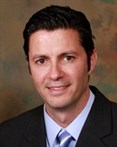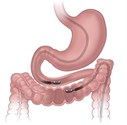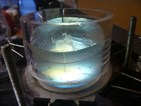Surgical Innovations' Accelerator program awards seed funding for commercially viable medical device ideas from UCSF innovators from any department through a bi-annual RFP process. Read about the projects supported in our first three cycles below.
If you have an idea that you would like to run by our team, please complete our project consultation form.
Fall 2018 Accelerator Projects
 Tabla
Tabla
Principal Investigator: Adam Rao
Department: Bioengineering & Therapeutic Sciences
Team members: Yasha Saxena, M.S.
Pneumonia is the number-one cause of death in children worldwide. The clinical gold standard for diagnosis--chest x-ray, which works by detecting inflammatory fluid in the lungs--is inaccessible to patients in low-resource settings due to prohibitive costs. Tabla aims to provide a rapid acoustic method of diagnosing pneumonia, expediting treatment, and saving lives. Read more >>
Principal Investigator: Miles Conrad, M.D., M.P.H. & Hugh McGregor, M.D.
Department: Radiology
Cholecystectomy for gallstone disease is one of the most commonly performed surgeries yet many patients are not candidates for surgery due to comorbidities. Gallbladder cryoablation is a minimally invasive, percutaneous, image-guided alternative to surgical cholecystectomy in which a needle is inserted from a skin puncture into the gallbladder. The gallbladder wall is then frozen which results in scarring, contraction, and involution. This project will focus on the development of a working prototype to perform cryoablation of the gallbladder efficiently, safely, and effectively. Read more >>
Principal Investigator: Elaine Tseng, M.D.
Department: Surgery
Team members: Liang Ge, Ph.D., John Ashley
When a Transcatheter Aortic Valve Replacement (TAVR) device is inserted into a patient’s heart there is a 3-10% chance of mal-positioning. A mal-positioned TAVR must be removed via open heart surgery or left in place with a second TAVR inserted inside it. There are no devices available to remove the mal-positioned TAVR without surgery. ReValve Med is developing a valve retriever system that can percutaneously remove a TAVR. Read more >>
Spring 2017 Accelerator Projects
 Percutaneous AV Fistula
Percutaneous AV Fistula
Principal Investigator: Shant Vartanian, M.D.
Department: Surgery
Team members: Dillon Kwiat, B.S.
Hemodialysis via an arteriovenous fistula have lower mortality rates than those dialyzed with a tunneled catheter and arteriovenous graft. They also have better durability, lower rates of revision, and lower rates of infection and hospitalization. We are developing a minimally invasive, percutaneous method of creating an arteriovenous fistula in the clinic for hemodialysis patients. Read more >>
Principal Investigator: David Conrad, M.D.
Department: Otolaryngology
Team members: Romain Roux, M.T.M.
Ensuring a tracheostomy tube stays in the neck and does not fall out (accidental decannulation) is critical in the postoperative and long term care in patients with tracheostomies. This wireless alarm system senses accidental decanulation and alerts a personal electronic device or nursing station. Read more >>
Principal Investigator: Matthew Haight, D.O. & Merlin Larson, M.D.
Department: Anesthesia
Team members: Sharvari Deshpande, M.S., Jeffrey Feng, B.S.
Epidural anesthesia is widely used to treat acute postoperative and obstetrical pain but there is no reliable method to manage the degree of pain blockade that these catheters provide.

Principal Investigators: Alexis Dang, M.D. & Alan Dang, M.D.
Department: Orthopaedic Surgery
Team members: Hash Pakbaz, Ph.D, Scott Semans, Sukhveer Sandhu, M.S.
Lighting plays a critical role in tissue visualization, surgical safety, and surgical speed. Our aims are to determine the optimal spectral lighting characteristics for highlighting various tissue types and building a surgical LED array that provides optimal surgical lighting for specific procedures. Read more >>
Fall 2015 Accelerator Projects
 Roboimplant: A Non-Invasively Expandable Implanted Rod for Orthopedic Surgery
Roboimplant: A Non-Invasively Expandable Implanted Rod for Orthopedic Surgery
Principal Investigator: Michael R. Harrison, M.D.
Department: Surgery
Team members: Dillon Kwiat, B.S.
The Roboimplant is a magnetically activated expandable intramedullary rod that can be non-invasively controlled and measure and influence bone healing in real time. Read more >>
 Sentinel Bandage: Monitoring Wounds with Non-Invasive Impedance Mapping
Sentinel Bandage: Monitoring Wounds with Non-Invasive Impedance Mapping
Principal Investigator: David M. Young, M.D.
Department: Surgery
A bandage to track whether a wound is improving or deteriorating allows clinicians to guide treatment accordingly and also offers a greater sense of safety to patients. Read more >>
Principal Investigator: Stanley J. Rogers, M.D.
Department: Surgery
The EMAP technology is a convenient addition to current quantitative monitoring of recovery from neuromuscular blockade which promises to reduce critical respiratory events and subsequent anesthesia malpractice claims. Read more >>
 Redesigning the ‘Hub Cap’ to Decrease Central Line Associated Blood Stream Infections (CLABSI)
Redesigning the ‘Hub Cap’ to Decrease Central Line Associated Blood Stream Infections (CLABSI)
Principal Investigators: Shyam Raghavan, M.D. and Lan Vu, M.D.
Department: Surgery
This project seeks to redesign the hub to protect the internal lumen and expose it for connection only under sterile conditions to decrease central line associated blood stream infections (CLABSI). Read more >>
Spring 2015 Accelerator Projects
 The Lamprey: A Novel Surgical Soft Tissue Manipulation/Retraction Device
The Lamprey: A Novel Surgical Soft Tissue Manipulation/Retraction Device
Principal Investigator: Insoo Suh, M.D.
Department: Surgery
Team members: Romain Roux, M.T.M.
The Lamprey Retractor is a novel surgical device for tissue contact and handling that provides effective manipulating ability without the traumatic effects of standard surgical instruments. Read more >>
 High-efficiency External Ambulatory Lung (HEAL)
High-efficiency External Ambulatory Lung (HEAL)
Principal Investigator: Benjamin Padilla, M.D.
Department: Surgery
Team members: Sukhveer Sandhu, M.S.
The High-efficiency External Ambulatory Lung is a novel approach in gas exchange membrane fabrication: specifically, a micron-thin film of PDMS supported by a specialized silicon microporous membrane to create an efficient and robust gas exchange membrane. Read more >>
 Contactless Bioimpedance Sensing for Transplant Rejection Detection and Monitoring
Contactless Bioimpedance Sensing for Transplant Rejection Detection and Monitoring
Principal Investigator: Georg Wieselthaler, M.D.
Department: Surgery
Team members: Tibor Wladimir
Our group is developing a contactless, implantable sensor that can continuously monitor transplanted tissue status. Read more >>

Getting Fit for Surgery: The b-Redy App
Principal Investigator: Emily Finlayson, M.D., M.S.
Department: Surgery
The b-Redy App acts as a personal health coach for older patients by actively engaging users in their efforts to get ready for surgery. Read more >>
 Endoscopic Magnetic Retractors
Endoscopic Magnetic Retractors
Principal Investigator: Matthew Y.C. Lin, M.D.
Department: Surgery
Our team is developing an endoscopic grasping device that is deployed onto the tissue of interest via standard endoscopic techniques, but can retract independent of the movement of the endoscopic itself, creating a significantly greater range of motion. Read more >>
 Magnetic Cardiac Assist Device (MCAD)
Magnetic Cardiac Assist Device (MCAD)
Principal Investigator: Neil Cambronero, M.D.
Department: Surgery
The Magnetic Cardiac Assist Device (MCAD) takes a different approach by circumventing the blood device interface altogether and directly assisting the mechanical pumping of the heart through the innovative application of magnetic force. Read more >>
Other Active Projects
 The Kidney Project: BioArtificial kidney for end stage renal disease
The Kidney Project: BioArtificial kidney for end stage renal disease
Principal Investigator: Shuvo Roy, Ph.D.
The Kidney Project is a national research effort based at UCSF utilizing the talents of a multidisciplinary team of scientists, engineers, and clinicians to tackle ESRD by developing a surgically implanted, free-standing bioartificial kidney. Read more >>

SmartDerm: Real-time monitoring & management for pressure ulcer prevention
Principal Investigator: Hanmin Lee, M.D.
SmartDerm proposes a comprehensive pressure ulcer prevention system consisting of intelligent sensor patches that continuously collect data across multiple modalities such as pressure and oxygenation, from which machine learning algorithms predict the likelihood of ulcer formation. Read more >>

Myoseal: A Novel Product for Hernia Prevention
Prinicpal Investigator: Hobart W. Harris, M.D., M.P.H.
MYOSEAL is a disruptive technology with the potential to shift the clinical focus of surgeons, payers, and the medical device industry from incisional hernia repair to incisional hernia prevention, ultimately certifying a new standard of care for abdominal surgery. Read more >>

Magnap: Magnetic Treatment for Obstructive Sleep Apnea
Principal Investigator: Michael R. Harrison, M.D.
MagNap is a magnet-activated treatment for OSA designed to be less invasive than reconstructive surgery, more tolerable than continuous positive airway pressure (CPAP), and more effective than non-invasive therapies for OSA. Read more >>

Magnamosis: Magnetic compression anastomosis device
Principal Investigator: Michael R. Harrison, M.D.
Magnamosis is a novel surgical device and method for creating an anastomosis, or connection between two tubular structures in the body, such as loops of intestine. Read more >>

Amnioseal: Preventing premature birth in fetal intervention
Principal Investigator: Michael R. Harrison, M.D.
The Amnioseal project is advancing the concept of pre-sealing the amniotic membrane prior to puncture by depositing a novel bio-inspired polymer adhesive in the space between the myometrium and the amniotic membrane. Read more >>

Magnetic Mini-Mover: Procedure for Pectus Excavatum
Principal Investigator: Michael R. Harrison, M.D.
The Magnetic Mini-Mover Procedure (3MP) is a novel minimally invasive method of correcting pectus excavatum developed in an effort to make the pectus excavatum operation better for patients and their families. Read more >>






